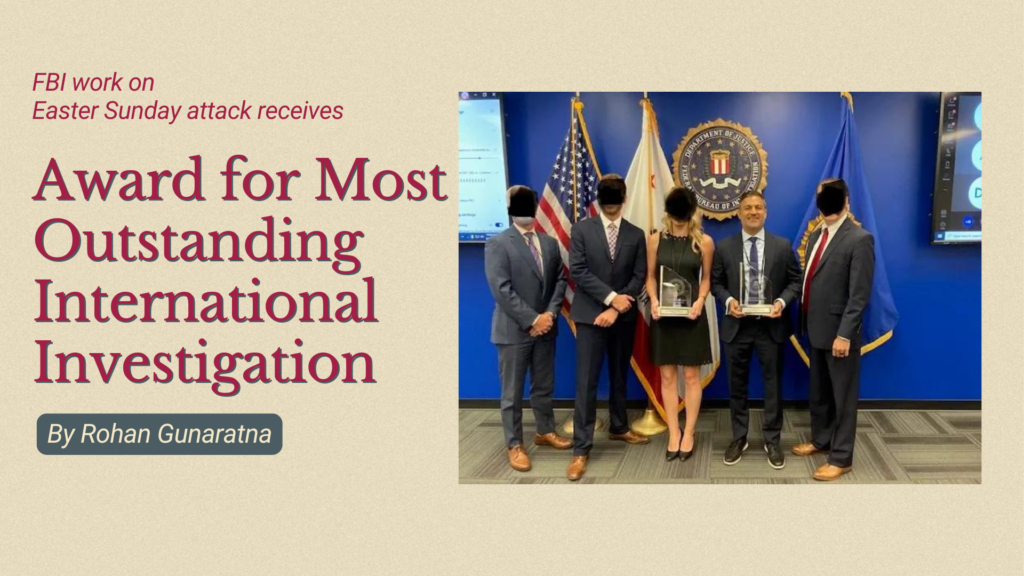
By Rohan Gunaratna
Introduction
The response of the United States of America especially the Federal Bureau of Investigation (FBI) into Sri Lanka’s Easter Sunday attack is a defining moment in the history of counter terrorism. Immediately after Sri Lanka’s Easter Sunday attack on April 21, 2019 that killed five US nationals, a FBI team located in Singapore flew into Colombo. In addition to the Assistant Law Enforcement Attaché from Singapore, to preserve the evidence in the attack sites, the FBI’s Special Agent Bomb Technician helped immensely. They were supported by the FBI Fly Team, a group of highly trained counterterrorism investigators—including special agents and intelligence analysts—based at FBI Headquarters who stand ready to deploy anywhere in the world on a moment’s notice. The Fly Teams strategic and tactical counterterrorism capabilities were enhanced by their partnership with other U.S. government agencies and foreign-partner nation entities in critical overseas locations to detect, penetrate, and disrupt terrorist networks.
When the Easter Sunday attack took place in Sri Lanka, I was visiting Fukushima, the site of a radiological disaster in Japan together with counter terrorism officials from the Prime Minister’s Office of Japan. Having publicly highlighted the persistent threat posed by the Islamic State since November 2016, I received a phone call from the staff of the National Security Council in Sri Lanka to meet with the government including the President.[1] While in Sri Lanka, I visited the attack sites in Sri Lanka’s Western and Eastern Province that were immediately secured by the Sri Lanka police to preserve the evidence. I met with some of the finest Sri Lankan law enforcement officers and also the men and women of the FBI who brought in unprecedented expertise and experience.
The initial team of FBI officers who flew into Sri Lanka successfully engaged with the US Embassy in Colombo and the Sri Lankan government. This engagement enabled a larger team of FBI investigators from the U.S. to travel to Sri Lanka. Together with Sri Lanka’s Criminal Investigations Department and its Counter Terrorism Division, three FBI teams investigated the attack.
- Evidence Response Team (ERT)
- Critical Analysis and Response Team (CART)
- High-value detainee interrogators
In parallel to US assistance, other foreign governments especially from countries that lost their citizens, dispatched their investigators and intelligence officers. In addition to the FBI and the US military, other US government agencies too supported Sri Lanka to build its capabilities to fight terrorism. The two governments that capacitated Sri Lanka to fight the threat were the Americans and Australians, notably the Australian Federal Police (AFP).
INTERPOL’s Incident Response Team (IRT) was deployed in Sri Lanka with specialists with expertise in crime scene examination, explosives, counter-terrorism, disaster victim identification and analysis. Additional expertise in digital forensics, biometrics, as well as photo and video analysis was added to the team on the ground. Furthermore, INTERPOL assistance led to the arrest of several Islamic State leaders and members overseas.
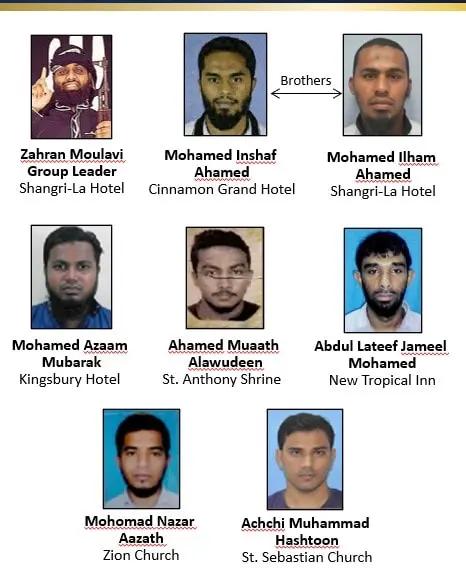
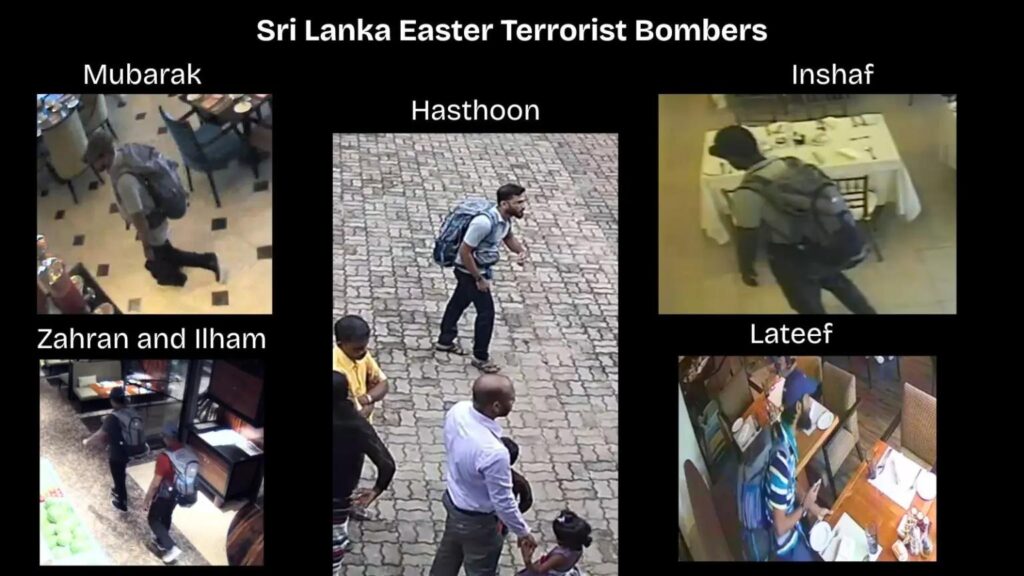
The FBI Findings
The FBI lead case agent Raj Patel flew to Sri Lanka together with members of the FBI’s Los Angeles Division’s Extraterritorial Squad. Raj was interviewed by Jerri Williams, a retired FBI agent, author and podcaster.
In his remarkably detailed interview, Raj dismantled myths and conspiracy theories that have clouded public memory in Sri Lanka.[2]
Excerpts from the discussion by Raj state:
“The Sri Lanka Easter bombings represented one of the most complex and high-pressure extraterritorial investigations ever undertaken by the FBI, demanding rapid mobilization, meticulous evidence collection, and a deeply victim-centered approach. For the agents involved, the first days and weeks were defined by a relentless rhythm that began in the early hours at the U.S. Embassy, followed by extensive fieldwork throughout Colombo and other affected areas, and concluded each night with detailed briefings and operational planning sessions. Each evening, specialized teams—including the Evidence Response Team (ERT), the Critical Analysis and Response Team (CART), and high-value detainee interrogators—would report their findings, while the ET squad agents coordinated strategy and assessed priorities. Late-night calls to FBI headquarters and supporting personnel in Los Angeles maintained a continuous, 24-hour operational link, ensuring that the unfolding investigation remained aligned with resources, legal requirements, and evolving intelligence. Guidance from experienced agents, particularly Marilee, who had previously worked large-scale terrorist attacks in Mumbai and Bali, provided crucial perspective and validation during this intense early phase, helping the ET squad maintain strategic focus and operational direction under immense pressure.”
“The initial response to the attacks involved careful coordination with Sri Lankan authorities and international law enforcement partners. Within hours of the bombings, the ET squad established operational command, assessing the immediate threat and determining who on the ground could provide support. At first, only a small group of three to five agents were deployed, including the Special Agent Bomb Technician (SABT), members of the ALAT from Singapore, and the flight team. Despite their small numbers, the team’s presence allowed for immediate engagement with local law enforcement, beginning with meetings at the U.S. Embassy and continuing with site assessments of blast areas and suspected safe houses. Coordination with the Sri Lankan Criminal Investigative Division (CID), led by Ranjith, proved invaluable, as it facilitated access to local detectives, evidence, and logistical support while fostering trust and cooperation with officials managing an overwhelming crisis under martial law conditions. This trust was essential, given Sri Lanka’s limited experience with radical Islamist terrorism and the unique challenges of post-civil war policing, which had previously focused largely on groups such as the Liberation Tigers of Tamil Eelam.”
“The ET squad faced the immediate task of processing the immense volume of evidence generated by multiple simultaneous bombings at churches and hotels. Initial priorities included DNA collection from detainees, fingerprint analysis, and processing of crime scenes by both the ERT and local law enforcement. As the investigation unfolded, it became clear that tangible, verifiable evidence would be critical for building a U.S.-based criminal case, given the uncertainties inherent in international prosecution, the potential for witnesses and detainees to change their stories, and the possibility of shifting cooperation from host-nation authorities. The agents relied heavily on forensic analysis of blast sites, safe houses, and bomb-making materials, documenting fingerprints, chemical residues, and structural damage. Every step of this evidence collection was executed with precision, from photographing lease agreements to tracing the purchase of chemicals and explosives used in the attacks. By directly linking suspects such as Rizkan and Sanasdeen to these materials through fingerprints and documentation, the team ensured that the case was anchored in concrete, irrefutable evidence rather than relying solely on statements or circumstantial findings.”
“Digital evidence was equally critical. The attackers had employed sophisticated operational security measures, destroying most of their phones and relying on encrypted peer-to-peer messaging via Threema. Despite this, investigators were able to gather substantial social media and digital communications that linked suspects to the ISIS-affiliated National Tauhid Jamaat (NTJ) network. CART personnel, augmented by experts from the Los Angeles field office and international partners from Australia, organized and processed hundreds of digital devices collected from safe houses and detainees. The establishment of a rigorous cataloging system enabled investigators to track the origin of each device, cross-reference user activity, and integrate these findings with physical evidence and interrogation results. By maintaining meticulous records, the ET squad minimized reliance on foreign authorities while ensuring that evidence was prosecutable in the U.S., recognizing that host-nation cooperation could fluctuate and that witnesses or detainees might alter their accounts over time.”
“Interrogations of detainees were a central component of the investigation, providing critical insight into suspect roles, operational planning, and logistical networks. The ET squad leveraged High-Value Detainee Interrogation Group (HIG) augmentees to conduct sophisticated interviews, ensuring that all statements were gathered in a legally defensible and tactically sound manner. Through these interrogations, investigators obtained details about chemical procurement, the assembly and testing of explosives, and the internal organization of NTJ and its ISIS-aligned affiliates. These findings were cross-referenced with physical and digital evidence to build a comprehensive narrative of the attacks. The team carefully resisted the urge to conduct premature interrogations, understanding that detainees might be deceptive and that the immediate goal was to secure concrete, verifiable links between suspects and evidence before moving into detailed interviews.”
“Throughout the operation, the ET squad maintained a victim-centered approach, prioritizing support and communication with the families of those killed or injured. Five Americans lost their lives in the bombings, including two dual U.K. citizens, a U.S. commerce employee working officially in Sri Lanka, an American businessman, and an 11-year-old boy from the D.C. area. Agents personally contacted victims’ families, establishing lines of communication to provide reassurance and updates, emphasizing the FBI’s commitment to justice and care for the affected families. Particular attention was given to the mother of the young boy, who had lost her only child in the attack and faced immense personal hardship, including caring for a grandmother with dementia and coping with the death of the child’s father. This personal engagement extended beyond the immediate investigation, with regular calls and visits to ensure ongoing support, underscoring the human stakes behind the operational and investigative work. The lead agent carried a photograph of the child in his office as a daily reminder of why the mission mattered, reflecting a deeply personal commitment to victims that informed decision-making throughout the case.”
“Operational challenges were compounded by the complexity of the attack itself. The NTJ network, led by Mohammed Qasim Mohammed Zahran, had planned and executed coordinated bombings, including suicide attacks involving members of Zahran’s family. The confrontations with these operatives highlighted the extreme risk environment in which the ET squad and local authorities operated. Detailed evidence collection, from fingerprints and chemical procurement records to lease agreements and surveillance footage, allowed investigators to establish clear links between specific individuals and acts of terrorism. The agents employed a methodical, step-by-step approach to ensure that all evidence could withstand scrutiny in U.S. courts. This approach involved cross-verifying information across multiple sources, maintaining direct control over critical evidence, and leveraging local expertise while safeguarding prosecutorial integrity.
Coordination with international partners was essential. The first four weeks saw engagement with representatives from 45 countries affected by the attacks, including substantial teams from Australia, the United Kingdom, and other nations. Daily briefings provided updates on investigative progress, evidence processing, and detainee management, while fostering collaborative relationships that enhanced operational efficiency. The ET squad established leadership over these meetings, ensuring that all partners were informed, aligned, and able to contribute effectively. Cooperation with the Sri Lankan CID and its head, Ranjith, was particularly significant, providing access to local investigators, ensuring cultural and procedural context was respected, and creating a partnership that facilitated evidence collection and operational planning. This collaboration highlighted the importance of building trust in international counterterrorism efforts, especially in nations with limited experience in handling complex terrorist attacks.
Evidence collection was exhaustive and methodical. Safe houses, blast sites, and chemical suppliers were meticulously documented, with photographs, fingerprints, and physical evidence collected and cataloged. The investigation traced the procurement of explosives, including water gel dynamite, and mapped the operational network of NTJ. Direct interaction with local vendors, landlords, and intermediaries allowed investigators to secure receipts, ledgers, and other records that tied suspects to illegal activities. The agents’ approach emphasized minimizing reliance on host-nation testimony, instead documenting direct evidence that could be presented in U.S. courts. These efforts ensured that the criminal complaint was supported by verifiable facts, reducing vulnerabilities associated with witness unreliability or jurisdictional complications.
The process of interrogations, evidence collection, and digital analysis continued over months. After initial deployments, smaller teams returned to maintain continuity and pursue remaining investigative leads. Agents revisited blast sites, verified safe house contents, and conducted further interrogations to fill gaps in knowledge. These operations included detailed tracking of chemical purchases, revisiting suppliers, and confirming the distribution of materials used in bomb-making. Surveillance footage from hotels, combined with fingerprint analysis, allowed investigators to tie individual suspects to specific operational acts. Digital forensics complemented these efforts, documenting social media activity and other online communications to establish the ideological affiliations and operational behaviors of NTJ members. These cumulative efforts resulted in a comprehensive understanding of the network, its members, and their respective roles, creating a robust evidentiary framework for prosecution.
Throughout the investigation, the ET squad maintained an unwavering focus on legal defensibility, operational effectiveness, and victim advocacy. Evidence was collected, documented, and corroborated to ensure prosecutorial viability in U.S. courts. Coordination with the U.S. Attorney’s Office and ongoing communication with FBI headquarters ensured alignment between investigative activities and the legal standards required for criminal complaints. The team’s approach combined operational agility, strategic patience, and meticulous attention to detail, reflecting the rigorous standards necessary for international counterterrorism investigations. At the same time, the agents’ consistent engagement with victims’ families reinforced the human-centered philosophy that underpinned all actions, demonstrating the Bureau’s commitment to justice, accountability, and empathy.
The Sri Lanka Easter bombings case exemplifies the complexity, scale, and human impact of modern terrorist investigations. It required rapid mobilization across continents, careful coordination with multiple agencies and international partners, and exhaustive evidence collection under challenging operational conditions. The ET squad’s focus on hard evidence, supported by forensic, digital, and testimonial corroboration, ensured the creation of a legally defensible case capable of withstanding scrutiny in U.S. courts. Simultaneously, the investigators’ dedication to victim care and personal engagement with affected families highlighted the moral and ethical dimensions of counterterrorism work, emphasizing that behind every operational decision lies the responsibility to protect and support human life. The investigation reflects a holistic approach to modern terrorism response, combining tactical precision, strategic coordination, and empathetic engagement to achieve justice and maintain public trust.”
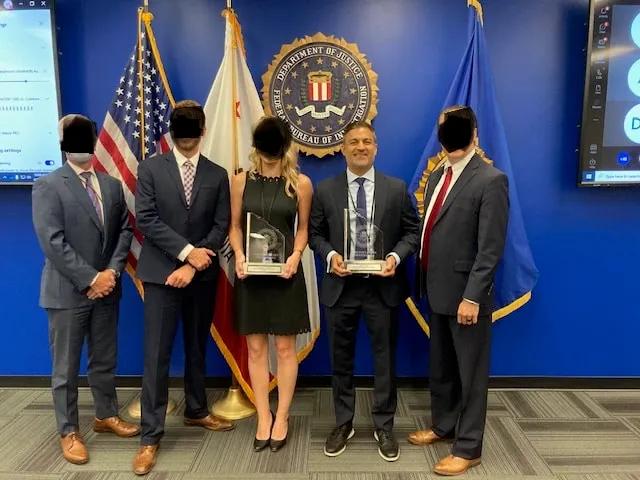
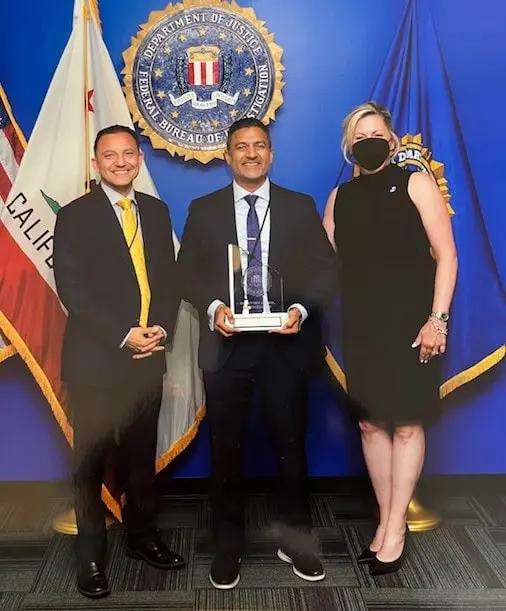
Other Reporting
The FBI, AFP, Interpol, and all the other investigative authorities stated that Sri Lanka’s Easter attack was conducted by the Sri Lanka Branch of the Islamic State. Unfortunately, a few Sri Lankans with personal and political interests have propagated a conspiracy theory. Without any evidence, the false narrative prompted by a few politicians and officials argue that Easter attack was staged by the RA&W, Sri Lankan intelligence, CIA and by the MOSSAD. The truth is distorted by unscrupulous politicians who want to capture or remain in power, poorly educated officials who want to curry favour with the politicians, unethical YouTubers who wants likes, separatists who have an axe to grind, and Muslim radicals who wishes to whitewash the extremists. I have documented all the reports on my website, and it is available for public viewing here.
The key findings of the FBI investigation is in a report and the interview given by the FBI Special Agent Raj Patel, the lead case agent that investigated the Easter Sunday attack. Raj who was on the Los Angeles Division’s Extraterritorial Squad at the time of the bombing, was designated the lead case agent. He was deployed for approximately 75 days (split between two deployments) to Sri Lanka, where he gathered the evidence to successfully indict three Non-United States Persons (NONUSPER) for providing material support to terrorism. For their work on this case, Raj and the other members of the team received the 2021 Director Award for Most Outstanding International Investigation. Raj’s interview is based on the evidence that is included in both the FBI investigation and the US Department of Justice announcement.
The interview by Raj complements the FBI affidavit (available here) on Sri Lanka’s Easter Sunday attack that details the investigation into Sri Lanka’s Easter Sunday attack. Merrilee R. Goodwin, a Special Agent with the FBI stated, “The coordinated, near-simultaneous attacks killed 268 individuals, including five U.S. citizens, and wounded more than 500 people. The attackers and their co-conspirators were members and supporters of ISIS and created a group, “ISIS in Sri Lanka,” hereinafter referred to by its name or, more generally, as the “group,” that ISIS formally recognized as an ISIS affiliate operating in Sri Lanka. ISIS claimed responsibility for the attacks via its news agency, declaring that “Islamic State fighters” had “targeted citizens of coalition states and Christians in Sri Lanka.” ISIS also posted a picture and video of the attackers swearing allegiance (“bayat”) to ISIS’s then leader, Abu Bakr al-Baghdadi (“al-Baghdadi”). Before detonating an IED that killed himself and scores of victims, Jahran Mohamed Cassim, also known as (“aka”) Mohamad Cassim Mohamad Zahran, aka Zahran Hashim (“Zahran”), was the mastermind behind the Easter Attacks and the self-proclaimed leader of ISIS in Sri Lanka.”
Of the law enforcement authorities worldwide, FBI, AFP and New Scotland Yard represents the gold standard. Their reports complement the fact-finding investigations and the local mechanisms by the Sri Lankan government and can be accessed on my website here.
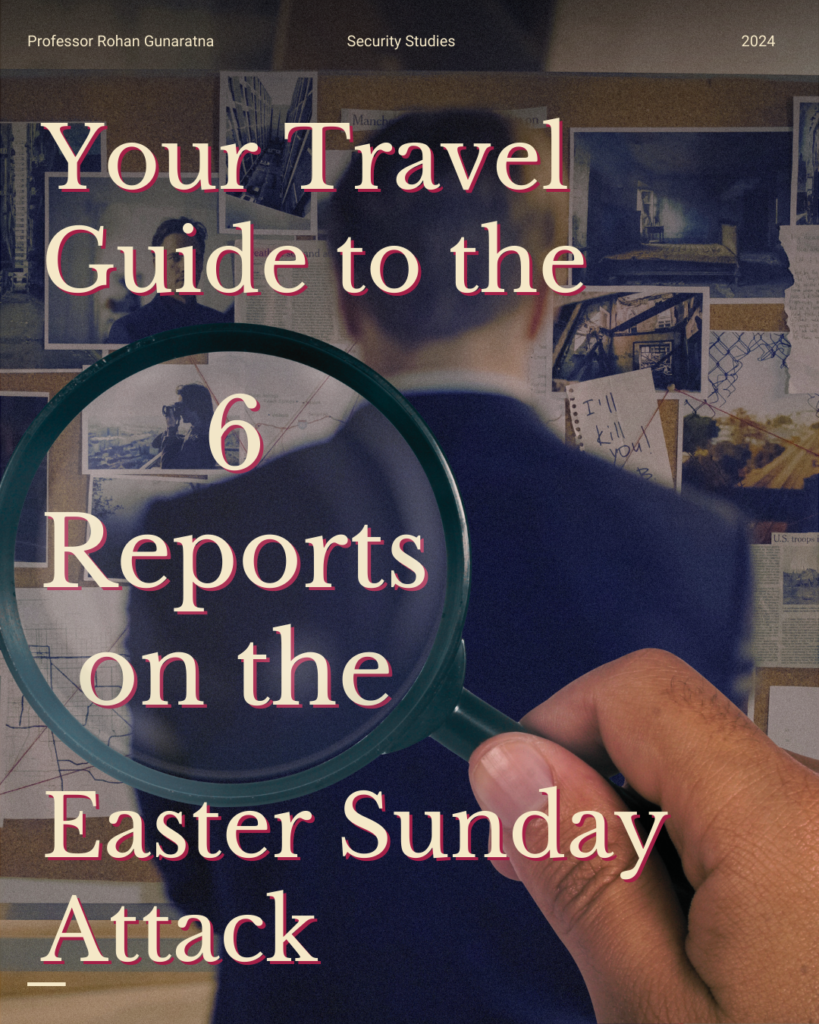
1. Report of the Special Three-Member Inquiry Panel on the Easter Sunday Attacks (June 10, 2019)
2. Report of the Parliamentary Select Committee on the Easter Sunday Attacks (October 23, 2019)
3. Report of the Parliamentary Sectoral Oversight Committee on National Security (February 19, 2020)
4. Report of the Presidential Special Commission of Inquiry into the Easter Sunday Bombings, Volume 1 (January 31, 2021)
5. Report of the Cabinet Ministerial Sub-Committee appointed on the implementation of the recommendations of the Presidential Commission on the Easter Sunday Attacks and the Oversight Committee on National Security (April 05, 2021)
6. Report of the Committee to investigate the facts of the program broadcast on Channel 4 regarding the Easter Sunday bombings (June 25, 2024)
7. Report of the Committee of Inquiry appointed under the chairmanship of retired Judge A.N.J. Alwis on Intelligence Coordination and Investigations into the Easter Sunday Bombings (September 14, 2024)
The US Dept of Justice Findings
The US Justice Department (US DoJ) announced on January 8, 2021 that three Sri Lankan citizens have been charged with terrorism offenses, including conspiring to provide material support to a designated foreign terrorist organization (ISIS). The US DoJ stated that the men were part of a group of ISIS supporters which called itself “ISIS in Sri Lanka.” The US DoJ added, “The group is responsible for the 2019 Easter attacks in the South Asian nation of Sri Lanka, which killed 268 people, including five U.S. citizens, and injured over 500 others, according to a federal criminal complaint unsealed today.
The complaint outlines the defendants’ roles in the conspiracy and the events that led to near-simultaneous suicide bombings in the Sri Lankan cities of Colombo, Negombo and Batticaloa on April 21, 2019. One of the U.S. citizens killed was a Department of Commerce employee who had traveled to Sri Lanka on official business.
Two days after the attacks, ISIS claimed credit for the terrorist acts, attributing the murders to “Islamic State fighters.” In late April 2019, the then-leader of ISIS praised the attackers for what he called a retaliation against “the West” for defeating ISIS the prior month in Baghuz, Syria.”[3]
“ISIS’s Easter attacks in Sri Lanka killed 268 people, including five Americans, many while they worshiped,” said Assistant Attorney General for National Security John C. Demers. “Today, we charge these defendants with bearing their share of the responsibility for these deaths. According to these charges, the defendants were committed supporters of ISIS, recruited others to ISIS’s violent cause, purchased materials for and made IEDs, helped to prepare and trained others who participated in the attacks, and murdered in the name of this deadly foreign terrorist organization. They are in custody in Sri Lanka. We fully support the Sri Lankan investigation and prosecution of these terrorists and will continue to work with the authorities there to pursue our shared goal of holding these defendants accountable for their crimes. At the same time, these charges reflect that the U.S. justice system remains a powerful tool to bring to bear against those who harm our citizens abroad. We will continue to pursue justice for the victims of these heinous attacks and for all American victims of terrorism.”
“This case clearly demonstrates that the United States will take decisive action to ensure terrorists face justice when they target Americans anywhere in the world,” said Nick Hanna, the U.S. Attorney for the Central District of California. “The United States remains confident in the Sri Lankan authorities’ ability to bring the perpetrators to justice – and this complaint makes clear that we stand ready with these charges in the event the defendants attempt to evade justice.”
“The domestic charges announced today for an attack on foreign soil represent the FBI’s commitment to deliver justice to traveling American victims and to protect U.S. interests here and abroad,” said Kristi K. Johnson, the Assistant Director in Charge of the FBI’s Los Angeles Field Office. “For decades, and particularly since 9/11, the FBI has deployed agents to various parts of the world to establish an investigative foothold and to liaison with local counterparts with a shared goal of combating terror globally. Our enduring hope is that criminal prosecution – whether domestic or foreign – will bring some peace to the hundreds of victims killed or injured in Sri Lanka as a result of this horrific attack.”
The US DoJ added, “The criminal case filed on Dec. 11, 2020, in the U.S. District Court in Los Angeles is the result of a nearly two-year investigation by the FBI, which assisted Sri Lankan authorities in the wake of the suicide bombings that targeted Christian churches and luxury hotels frequented by Westerners. The defendants named in the complaint, along with other suspects linked to the attacks, currently are detained in Sri Lanka, where a criminal investigation is ongoing.
According to the complaint, the three charged defendants and others involved in the conspiracy – including eight terrorists who died in the suicide bombings – conspired to provide, provided, and attempted to provide material support, including services and personnel, to ISIS through various actions, including: (1) creating, maintaining, and serving as members of a group of ISIS supporters in Sri Lanka devoted to ISIS, its ideology, and to planning and encouraging violent attacks to advance ISIS’s goals; (2) obtaining explosive materials and IED components; (3) manufacturing and testing IEDs, including the types of IEDs ultimately used in the attack; (4) recruiting other ISIS in Sri Lanka members; (5) using ISIS-created training materials to instruct and train the attackers and their co-conspirators in the use of firearms and explosives; (6) procuring safe houses for the group to prepare for attacks in the name of ISIS, including the Easter Attacks, while avoiding law enforcement detection; (7) following ISIS directives to use specific end-to-end encrypted messaging applications to conceal the criminal conspiracy; (8) murdering two Sri Lankan police offers to obtain the officers’ firearms; and (9) shooting a suspected police informant.” <https://www.justice.gov/archives/opa/pr/three-foreign-nationals-charged-conspiring-provide-material-support-isis>
The three defendants named in the criminal complaint, all of whom pledged allegiance to ISIS, are:
- Mohamed Naufar, the “second emir” for the group of ISIS supporters that called itself “ISIS in Sri Lanka,” who allegedly led the group’s propaganda efforts, recruited others to join ISIS, and led a series of multi-day military-type trainings;
- Mohamed Anwar Mohamed Riskan, who allegedly helped manufacture the IEDs used in the Easter Attacks; and
- Ahamed Milhan Hayathu Moahmed, who allegedly executed a police officer in order to obtain the officer’s firearm, shot a suspected informant, and scouted a location for a separate terrorist attack.
The U.S. DoJ stated, “All three defendants are charged with conspiring to provide, providing, and attempting to provide material support to a designated foreign terrorist organization. Additionally, Naufar and Milhan are charged with aiding and abetting the receipt of military-type training from ISIS.
The FBI-led Joint Terrorism Task Force in Los Angeles, including personnel assigned responsibilities for extraterritorial matters, is leading the investigation. This matter is being prosecuted by Assistant U.S. Attorneys Annamartine Salick, George E. Pence IV and Christine M. Ro of the Terrorism and Export Crimes Section, and Trial Attorney Alicia Cook of the National Security Division’s Counterterrorism Section. The Criminal Division’s Office of International Affairs provided valuable assistance.”[4]
The Next Course of Action
Based on the evidence, both Sri Lankan and foreign investigators categorically stated that Sri Lanka’s Easter Sunday massacre was conducted by the Sri Lanka branch of the Islamic State. Although the Sri Lankan intelligence community issued 337 reports warning the government of an impending threat, the politicians and bureaucrats failed to act. As opposed to Sri Lanka’s vast experience of tackling separatist terrorism, Raj Patel states that the government authorities had, “limited experience with radical Islamist terrorism”. That should not have been the case.
With the intelligence community informing the politicians and bureaucrats, they should have planned and prepared to tackle a visible threat.
Sri Lankan intelligence community issued 337 intelligence reports to the Sri Lankan National Security Council, IGP, and CID about the threat of Muslim exclusivism, extremism, violence and terrorism from January 2015-April 2019.
The reports originated from the
- State Intelligence Service (SIS)
- Military Intelligence (MI)
- Police Special Branch (SB)
- Western Province Intelligence Service (WPIS)
- Naval Intelligence (NI)
- Air Intelligence (AI)
- Special Task Force Intelligence (STF Intelligence)
The 337 reports refer
- Islamic State (ISIS)
- Zahran Hashim
- Muslim radicalisation
However, President Maithripala Sirisena did not act. Dependent on Muslim votes, politicians compromised national security. When Justice Minister Wijedasa Rajapaksa said in parliament 32 Sri Lankan Muslims had travelling to Syria in November 2016, the radical Muslim MPs attacked him. The 32 Sri Lankan Muslims were from “well-educated and elite” families demonstrating that Muslim radicalisation was no longer a peripheral threat. The tragic consequence of inaction was the Easter Sunday attack.
Today, there is a grave failure by the government to acknowledge the truth and take decisive action to rehabilitate the terrorists in custody and prevent the ongoing community radicalisation. Otherwise, future attacks are inevitable. In parallel to developing rehabilitation and prevention programs, government should take decisive action against both politicians and government officers who have neglected their duties in the light of both the foreign and domestic intelligence reports. It is also imperative to take action against the religious leaders who did not protect the religious space. It is also imparative to take action against those who deliberately and maliciously spread fake news about the Easter Sunday attack.
Government should build a multi stakeholder counter terrorism capability to respond to the persistent threat of radicalisation. In the Sri Lankan case, it is not only radicalisation of the Muslims. However, there are politico-religious organisations some operating openly and others underground radicalising Buddhists, Hindus and Christians. Protecting the religious peace between the communities is vital to preserve national unity.
Conclusion
The world’s worst act of international terrorism is the 9/11 attack where 2,996 died (2,977 victims + 19 Al-Qaeda terrorists) and 6,000–25,000 people were injured.
The second worst act of international terrorism was the Hamas attack on October 7th 2023, where 824 civilians were killed, 678 security forces were killed, 10,580 were wounded, 253 were captured or abducted and 1 is missing.
Although at the time it was staged, Easter attack in Sri Lanka on April 21, 2019 was the world’s second worst act of international terrorism, after the Hamas attack, the Easter attack ranks the third worst attack.
In Sri Lanka, 269 people were killed, including 45 foreign nationals, three police officers, and eight suicide bombers. In addition to injuring over 500, the attack gravely damaged tourism, the mainstay of Sri Lanka’s economy. The three catastrophic attacks were respectively claimed by Al Qaeda, Hamas and the Islamic State.
Sri Lanka’s response to the coordinated series of attacks carried out across Sri Lanka targeting Easter Sunday church services and popular tourist’s hotels, killing locals and foreigners, was to invite foreign governments to work with its investigative authorities and intelligence agencies. In the light of the foreign investigative reports and 337 Sri Lankan intelligence reports from 2015-2019, it is paramount for the Sri Lankan government to acknowledge the truth. Without politicians unwilling to tell the truth to the public, the government will not build the capabilities to fight the current and emerging threat.
Easter Sunday attack has become a political football for governments to come to power and to remain in power. Furthermore, religious authorities and politicians should not interfere in investigations. As long as national security is compromised for political and personal gain and the very real threat is not addressed, the likelihood of another attack is certain.
Rohan Gunaratna is the author of Sri Lanka’s Easter Sunday Massacre – Lessons for the International Community (Penguin) and in Sinhala, Sri Lanka’s Easter Sunday Massacre- Lessons to be Learnt (Sarasavi).
[1] https://terroristinformation.wordpress.com/2019/06/11/there-are-a-few-hundred-isis-supporters-in-sri-lanka-prof-rohan-gunaratna
[2] https://jerriwilliams.com/364-raj-patel-sri-lanka-easter-bombings-2019-extraterritorial-jurisdiction
[3] https://www.justice.gov/archives/opa/pr/three-foreign-nationals-charged-conspiring-provide-material-support-isis
[4] https://www.justice.gov/archives/opa/pr/three-foreign-nationals-charged-conspiring-provide-material-support-isis